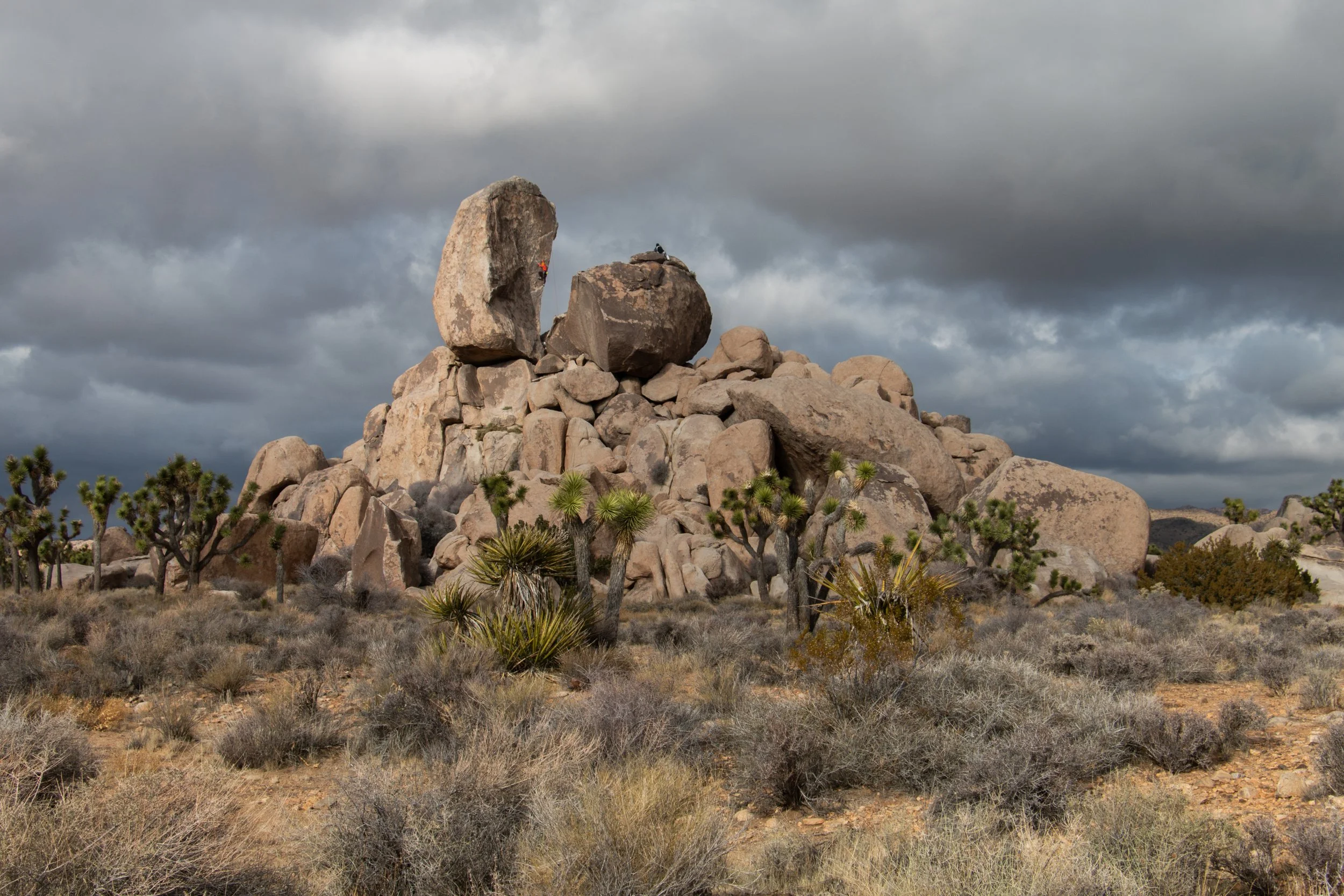Rock Climbing
All photography © Paul Martinez
in Joshua Tree National Park
Joshua Tree National Park is one of the world’s premier destinations for rock climbing and bouldering, drawing climbers from around the globe. The park’s unique rock formations offer thousands of climbing routes, making it a must-visit location for climbers of all skill levels—from beginners to advanced climbers.
However, it’s essential to prepare properly and climb responsibly to ensure a safe and enjoyable experience.
Overview of Climbing in Joshua Tree
Types of Climbing: Joshua Tree offers a variety of climbing opportunities, including traditional climbing, bouldering, and sport climbing.
Skill Levels: The park features more than 8,000 climbing routes that range from beginner-friendly climbs to expert-level routes.
Accessibility: While many climbing areas are easy to access, others are more remote and require off-trail navigation.
The most popular seasons for climbing are fall, winter, and spring, as summer temperatures can reach dangerously high levels. Keep in mind that conditions vary, so it’s important to plan accordingly.
Climbing Guidelines and Regulations
To protect the park’s resources and provide a safe experience for everyone, climbers are required to follow these rules:
Permits:
A permit is required for any overnight climbing trips or if you plan to camp at backcountry climbing areas.
Permits can be obtained from the park’s visitor centers.
Group Size Limits:
Groups are limited to 12 climbers per area to minimize environmental impact and reduce crowding.
Bolts and Anchors:
The placement of new bolts or fixed anchors is prohibited without approval from the park.
Climbers should use existing anchors whenever possible and avoid causing unnecessary damage to the rocks.
Climbing Closures for Wildlife Protection:
Certain areas may be temporarily closed to protect nesting raptors or sensitive wildlife habitats.
Check with the visitor center or the NPS website for up-to-date information on closures.
Leave No Trace:
Practice Leave No Trace principles by packing out all trash, minimizing chalk use, and staying on established trails to access climbs.
Avoid damaging plants and cryptobiotic soil crusts near climbing routes.
Climbing Safety Guidelines
Joshua Tree’s rugged terrain and unpredictable weather require climbers to exercise caution. Keep the following safety tips in mind:
Assess Your Skills and Limits: Choose routes appropriate to your ability level and have a clear understanding of the climb’s technical requirements.
Use Proper Gear: Always wear a helmet, use a reliable belay system, and ensure your climbing equipment is in good condition.
Be Weather-Aware: Sudden changes in weather, such as high winds or rain, can make climbing dangerous.
Emergency Preparedness:
Cell service is limited in many areas.
Carry a first aid kit, extra water, and food.
In case of an emergency, contact park rangers or call 911.
Popular Climbing Areas in Joshua Tree
Hidden Valley:
A popular climbing area with routes for all skill levels.
Known for its short approach trails and scenic setting among boulders.
Indian Cove:
Offers both beginner and intermediate routes, with camping available nearby.
A great spot for those looking to combine camping and climbing.
Jumbo Rocks:
Ideal for bouldering enthusiasts with easy access to challenging rock formations.
Perfect for climbers who want to explore without technical climbing gear.
Ryan Mountain Area:
Known for its more advanced routes and longer approaches.
Offers panoramic views from higher elevations.
Best Seasons for Climbing
Fall and Spring: Temperatures are mild, making these the most popular seasons for climbing.
Winter: Climbing is still possible, but be prepared for cold conditions, especially at night.
Summer: Climbing during summer is not recommended due to extreme heat. If you do climb, start early in the morning or late in the afternoon and bring plenty of water.
Climbing Resources
Guidebooks: There are several climbing guidebooks available that provide detailed information on routes, ratings, and difficulty levels.
Visitor Centers: Stop by one of the park’s visitor centers to get the latest information on climbing conditions and closures.
Local Climbing Gyms: If you’re new to the sport, consider visiting a climbing gym in the area to practice before heading into the park.
Respect the Environment and Fellow Climbers
Climbing in Joshua Tree is an incredible experience, but the park’s fragile ecosystem requires thoughtful care from all visitors. Respect other climbers by following good climbing etiquette, including taking turns on popular routes and keeping noise to a minimum. Protect the landscape by sticking to trails, packing out trash, and minimizing environmental impact.
By climbing safely and responsibly, you can help preserve this world-class destination for future generations.




